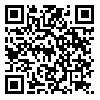BibTeX | RIS | EndNote | Medlars | ProCite | Reference Manager | RefWorks
Send citation to:
URL: http://jdisabilstud.org/article-1-3229-en.html
2- Professor, Department of Psychology, Urmia Branch, Islamic Azad University, Urmia, Iran
3- Assistant Professor, Department of Psychology, Urmia Branch, Islamic Azad University, Urmia, Iran
Abstract
Background & Objectives: Mood–related patterns show a daily rhythmic pattern. The present study aimed to investigate the relationship between the mood rhythm and personality factors of Hexaco among students. Global disease research reports that mental health conditions are among the leading causes of disability worldwide, and it is predicted that major depression will be the number one cause of disability by 2025. It has been well established that the abnormality in the sleep–wake cycle and circadian rhythms of activity–rest are related to changes in mood states, and this relationship has been observed at the molecular, physiological, and behavioral levels. However, little is known about the 24–hour rhythm of other behavioral and physiological functions, such as mood, cognitive abilities, appetite, and social interaction.
On the other hand, a lot of evidence supports the idea that circadian rhythm disorders play an essential role in the pathology of mood disorders. Still, more research is necessary to understand this issue better. Circadian typology reflects individual differences in the biological rhythms of the biological clock. Studies have shown that five personality factors play a significant role in forming people's mood rhythms. In general, mood rhythms are the essential characteristics of people, related to a wide range of individual traits influenced by society, education, academic performance, aging, and sexual relations. However, despite the unique importance of mood rhythm, few research studies have been conducted on its relationship with personality traits. Also, based on the investigations conducted in this research, no study deals with the relationship between mood rhythm and personality factors of Hexaco.
Methods: The current research was analytical and of the correlational type. The statistical population included all students of Urmia University, Urmia City, Iran, in 2022. According to the minimum sample required for factor analysis, 250 people is enough; however, 340 people were selected by the multi–stage cluster sampling method. In this way, among the faculties of Urmia University, 10 faculties were selected randomly. Then, 34 students were randomly selected from each faculty and answered the Mood Rhythm Instrument (De Oliveira et al., 2020) and the Hexaco Personality Inventory (Ashton and Lee, 2004). The inclusion criteria were as follows: informed consent, age range of 18 to 36 years, and not taking psychiatric drugs. The exclusion criteria were as follows: providing incomplete information and refusing to complete the questionnaires. Also, to comply with the ethics of the research, while informing all the participants about the objectives of the research and obtaining informed consent from the units under study, the optionality of participating in the research, the right to withdraw from the study, and making the results available if desired, were mentioned. Ethical considerations were observed in all stages of the research. Also, issues related to the safety and well–being of participants and data privacy were monitored during the study. The Pearson correlation coefficient and multiple linear regression analysis were used for data analysis in SPSS version 22 software. The significance level of all tests was 0.05.
Results: The results showed that the cognitive component (mood rhythm) had a negative and significant relationship with conscientiousness (Hexaco) (r=–0.115, p<0.05) and had positive and significant relationships with emotionality (Hexaco) (r=0.176, p<0.01) and openness (Hexaco) (r=0.153, p<0.01). Also, the physical component (mood rhythm) had a positive and significant relationship with emotionality (Hexaco) (r=0.173, p<0.01) and had negative and significant relationships with agreeableness (Hexaco) (r=–0.130, p<0.05) and conscientiousness (Hexaco) (r=–0.262, p<0.01). Finally, the emotional component (mood rhythm) had a negative relationship with conscientiousness (Hexaco) (r=–0.266, p<0.01) and a positive relationship with emotionality (Hexaco) (r=0.300, p<0.01). The research results showed that Hexaco personality factors significantly correlate with mood rhythm.
Conclusion: According to the present research findings, there is a relationship between mood rhythm and Hexaco personality factors. This finding suggests that people with certain personality traits may be more prone to mood swings throughout the day. Further research is needed to determine this relationship's underlying mechanisms and potential consequences.
| Rights and permissions | |
 |
This work is licensed under a Creative Commons Attribution-NonCommercial 4.0 International License. |



